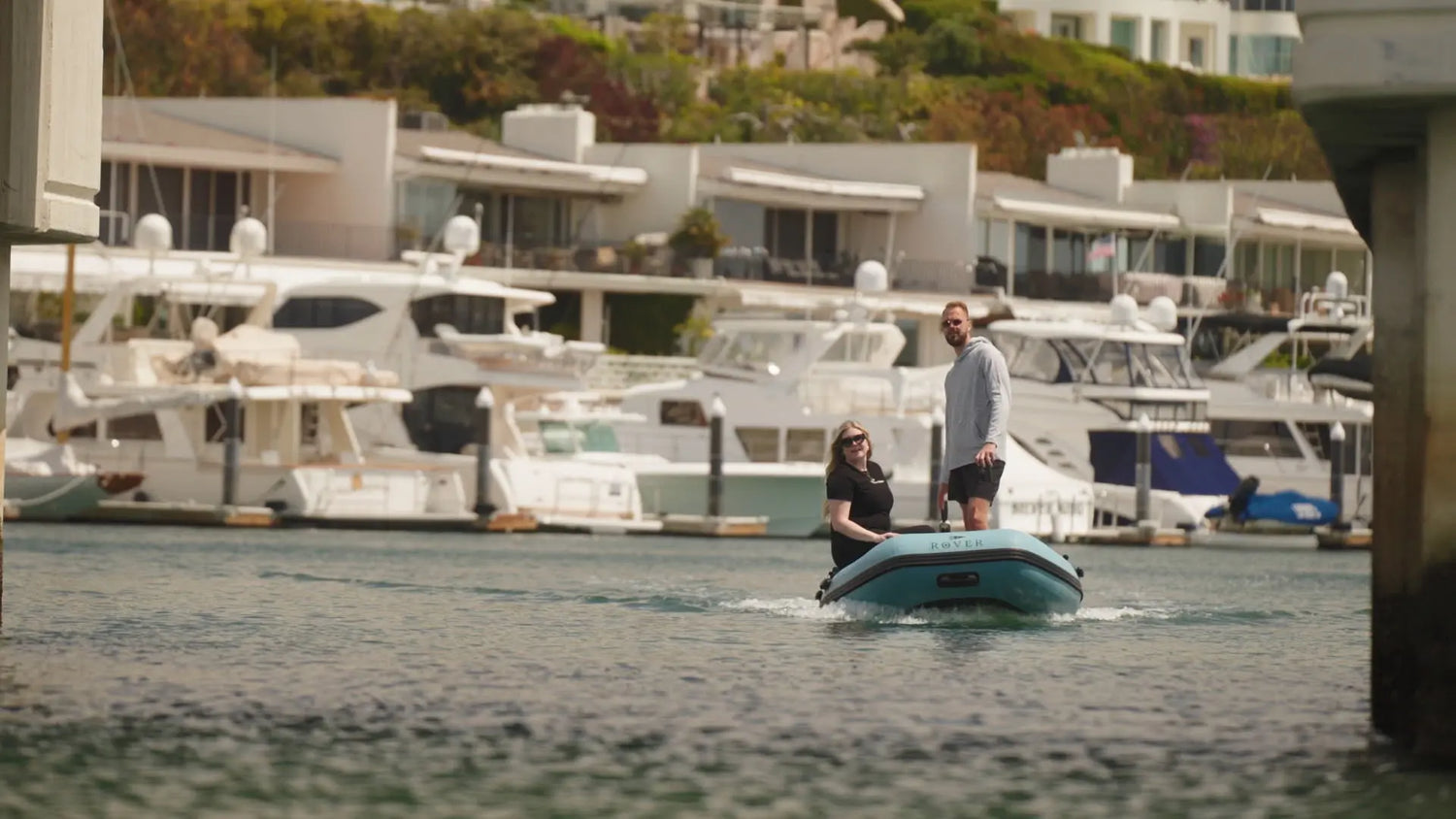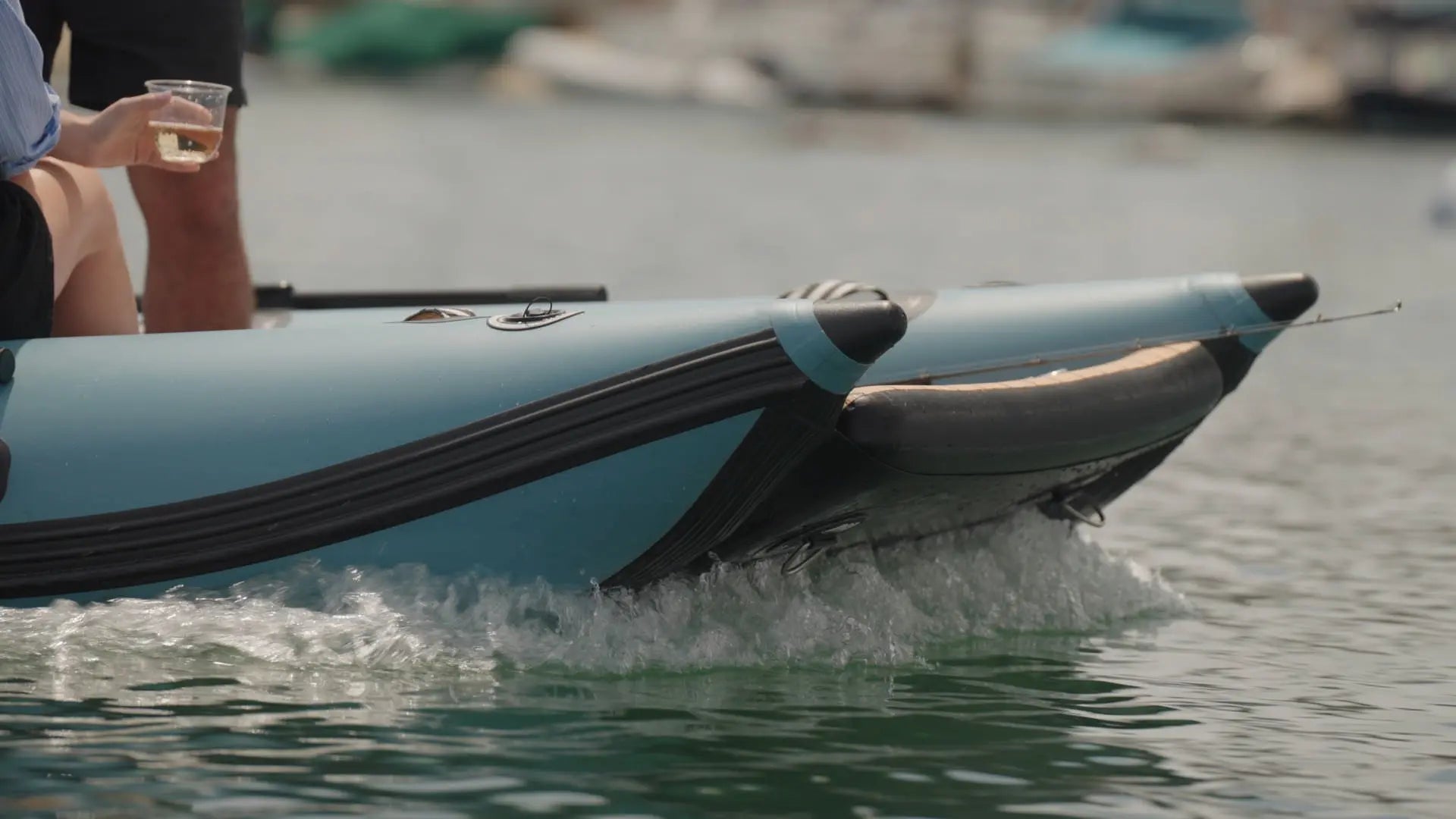Small vs. Large Inflatable Dinghies: Your Ultimate Size Guide for Choosing the Perfect Tender
Picking the right inflatable dinghy size can dramatically enhance your adventures on the water, whether you're a boat owner, a diver, or an angler heading ashore. This guide breaks down inflatable dinghy sizes, covering length and beam measurements, weight and capacity differences, and how these dimensions impact portability and storage. You'll learn the advantages of both small and large dinghies, key factors to consider like intended use, gear needs, hull and floor types, and engine compatibility for both electric and gas outboards. We'll also touch on best practices for towing, maintenance, and showcase examples from Battle Boat and Battle Cat. By understanding these distinctions, you'll be well-equipped to select the perfect tender for your boating lifestyle.
What Sets Small and Large Inflatable Dinghies Apart? Size Categories and Key Measurements
The classification of inflatable dinghies into "small" and "large" categories is primarily based on their overall length and beam. These measurements directly influence stability, how much they can carry, and how easily they can be stored. Generally, small dinghies measure under 9 feet, offering a compact and lightweight solution. Large dinghies, on the other hand, typically start around 10 feet and can extend beyond 15 feet, providing more space and better performance in varied conditions. Knowing these ranges is crucial for making informed purchasing decisions and for practical handling on your vessel.
Beyond just length and beam, the hull shape of small and large dinghies also plays a role in how they perform, affecting how quickly they plane and how they handle waves. Smaller dinghies tend to get on plane more easily with less horsepower, while larger, wider dinghies can handle more weight and offer a smoother ride when conditions get choppy. Let's dive into the specific dimensions.
| Size Category | Typical Length | Typical Beam | Average Weight | Passenger Capacity Range |
|---|---|---|---|---|
| Small | 6 ft – 9 ft | 3 ft – 4 ft | 50 lbs – 100 lbs | 1 – 3 people |
| Large | 10 ft – 15 ft+ | 5 ft – 7 ft | 150 lbs – 300 lbs | 4 – 8 people |
These figures highlight how larger vessels are designed to carry more people and gear, offering greater stability and capability when you venture further from shore. Examining their weight and passenger capacity further clarifies the differences in how they are handled and operated.
What Are the Typical Lengths and Beams for Small vs. Large Dinghies?
Small inflatable dinghies, typically measuring between 6 and 9 feet in length with beams of 3 to 4 feet, are fantastic for quick deployments and take up minimal space when stowed. Their compact size makes them easy to lift with davits or stow on deck. In contrast, large dinghies range from 10 feet up to 15 feet or more in length, with beams from 5 to 7 feet. These larger models often require more substantial lifting systems like cranes or specialized davits, but they provide a much more stable platform for multiple passengers and significant gear. Understanding these size brackets helps clarify deployment options and the onboard space requirements, leading us to the next important considerations: weight and capacity.
How Do Weight and Passenger Capacity Differ Between Small and Large Dinghies?
Small dinghies usually weigh under 100 lbs and can comfortably carry up to three people, making them manageable for a single person during launch and retrieval. Larger models, often exceeding 150 lbs, might require two people or mechanical assistance to handle, but they can safely accommodate four to eight passengers along with substantial gear for activities like diving or fishing. This relationship between weight and capacity directly influences the type of engine you can use and how you plan your loads, which in turn affects how portable and easy to store the dinghy is.
How Does Size Impact Portability and Storage Needs?
A 7-foot small dinghy can be inflated in just a few minutes and folded down to fit neatly into a yacht's garage or under a deck seat, making the most of limited space. On the other hand, a 12-foot large dinghy will likely need to be stored folded on deck or require custom cradles, and might even need a dedicated trailer for transport. Smaller dinghies are often suitable for car-topping and solo handling, while larger ones trade some portability for increased capacity and better performance in rougher seas. Grasping this trade-off between portability and capacity is key to selecting the dinghy size that best suits your boating lifestyle and available storage.
Research consistently shows a strong link between dinghy size and ease of transport and storage. Smaller dinghies, due to their more compact folded dimensions, are significantly easier to handle during launch and retrieval and fit into tighter storage spaces.
Marine Equipment Insights (2023)
What Are the Benefits of Choosing a Small Inflatable Dinghy?
Small inflatable dinghies offer unparalleled convenience, agility, and affordability, making them ideal as yacht tenders, for quick trips to shore, or for solo fishing excursions. Their compact design and lighter weight simplify launching and maintenance, presenting a cost-effective choice for boat owners with limited deck or storage space. These advantages translate into quicker setup times, lower upkeep expenses, and seamless integration with electric outboards designed for lighter loads.
How Does Portability Make Small Dinghies Ideal for Yacht Tenders and Quick Trips?
The exceptional portability of small dinghies means they can be effortlessly transported and stored in modest lockers or deck cradles. Their inflatable tubes and floors pack down flat, allowing for rapid inflation and deflation right at the dock. This high degree of portability ensures that yacht crews can deploy a tender in minutes for crew changes or provisioning runs, boosting operational efficiency and guest satisfaction while preserving valuable deck space.
Why Are Small Dinghies More Maneuverable in Tight or Shallow Waters?
With their narrower beams and shorter hulls, small inflatable dinghies respond quickly to steering commands and have a shallow draft, allowing operators to navigate crowded marinas and shallow anchorages without the worry of running aground. Their agility also means they create less wake in confined areas, which is better for shorelines and other boats. This maneuverability is invaluable when docking in tight spots or beaching.
What Cost and Maintenance Advantages Do Small Inflatable Dinghies Offer?
Small dinghies typically come with lower initial purchase prices and reduced annual maintenance costs. Their smaller fabric panels and fewer seams mean fewer potential points for leaks, and their lighter construction makes cleaning and repairs simpler. Storage costs are also minimized due to their smaller footprint, and their compatibility with low-horsepower or electric outboards leads to lower fuel expenses and initial engine costs. These savings make small dinghies a smart, economical choice for budget-conscious boaters.
What Advantages Do Large Inflatable Dinghies Provide for Marine Activities?
Large inflatable dinghies serve as highly versatile platforms for family adventures, diving expeditions, and transporting substantial gear. Their longer hulls and wider beams offer superior stability, increased capacity for both passengers and cargo, and the ability to handle more powerful engines for higher speeds and better planing performance. These features make them capable workhorses that can handle a variety of sea conditions with confidence.
How Does Stability Improve with Larger Inflatable Dinghies?
Larger dinghies achieve enhanced stability, both initially and as they encounter waves, thanks to their wider beams and longer waterlines. This design reduces rolling in choppy conditions and provides a more solid platform for standing. This superior stability is particularly important for activities like diving, fishing, and transporting passengers who need secure footing. By incorporating built-in buoyancy chambers and robust hull structures, these vessels maintain their balance even under heavier loads.
Studies confirm that larger vessels, including inflatable dinghies, generally offer improved stability. This is attributed to their wider beams and longer waterlines, which result in less rolling in choppy seas and a more secure platform for occupants. This enhanced stability is critical for activities such as diving and fishing.
Journal of Naval Architecture (2022)
Why Is Increased Capacity Important for Family Outings and Diving Expeditions?
A larger inflatable dinghy provides ample space for additional passengers and bulky equipment like dive tanks, fishing rods, and coolers, all without compromising safety. The higher freeboard helps minimize spray coming aboard, adding comfort for those seated near the tubes. Families and dive groups can take advantage of extended seating and dedicated gear storage, allowing for longer excursions with all necessary supplies readily accessible.
How Do Larger Dinghies Support More Powerful Engines and Better Performance?
The reinforced transoms found on larger inflatables are designed to handle outboards ranging from 15 HP up to 30 HP or more. This allows for faster planing speeds and quicker transitions onto plane, especially when carrying heavier loads. Higher horsepower engines improve acceleration and can actually enhance fuel efficiency at cruising speeds by allowing the engine to operate within its optimal RPM range. This performance boost extends your operational range and reduces travel time to dive spots or remote anchorages.
How to Choose the Right Inflatable Dinghy Size for Your Needs? Key Factors Explained
Selecting the ideal dinghy size involves matching the vessel's features to your primary use, passenger and gear requirements, available storage and towing capabilities, and your preferences for hull and floor types. Carefully considering these factors will ensure your chosen tender maximizes both its utility and your enjoyment on the water.
How Does Intended Use Influence Your Dinghy Size Choice?
Different activities call for specific dinghy characteristics. If you need a yacht tender, a compact model for quick deployment is best. For fishing trips, a moderately sized dinghy offers better stability for casting lines. Diving expeditions require a larger platform to comfortably stow tanks and gear, while watersports demand a planing hull with enough beam for tow points. Here’s a quick guide:
| Primary Use | Recommended Dinghy Size | Key Considerations |
|---|---|---|
| Yacht Tender | 6 ft – 9 ft | Portability, quick inflation, davit compatibility |
| Fishing | 8 ft – 10 ft | Stability, rod holders, storage pockets |
| Diving | 11 ft – 15 ft+ | Deck space, transom strength, freeboard |
| Watersports | 10 ft – 13 ft | Planing efficiency, tow eye, beam width |
What Passenger and Gear Capacity Should You Consider?
Always estimate the total weight of your intended passengers and gear, and then select a dinghy with at least a 20 percent buffer above that load. For example, if you plan to carry two divers with all their equipment, choose a dinghy rated for at least four people to avoid overloading. This safety margin helps extend the life of the tubes and ensures proper buoyancy, especially under dynamic conditions.
How Do Storage and Towing Capabilities Affect Dinghy Size Selection?
You'll need to check if your vessel's davits or trailer have the capacity to handle the dinghy's folded dimensions and weight. Smaller tenders often fit on lighter-duty davits, while larger inflatables might require reinforced cradles or custom-built trailers. Also, consider your driveway space and local boat ramp access, as these can dictate the maximum size and weight you can safely tow and store.
What Role Do Hull and Floor Types Play in Size and Performance?
The rigidity of the hull and the construction of the floor significantly impact how the dinghy tracks, its stability, and its resistance to abrasion. Rigid inflatable boat (RIB) hulls and aluminum floors provide excellent stiffness and planing performance, whereas air or composite flat floors prioritize lightweight portability. Matching the floor type to the dinghy size ensures that its performance characteristics—whether it's precise tracking or rapid inflation—align with your intended use.
Which Electric and Gas Outboard Engines Are Compatible with Small and Large Inflatable Dinghies?
Engine compatibility hinges on the dinghy's transom rating and your desired performance level. Small inflatables pair nicely with lightweight electric outboards under 1 kW, while larger tenders can accommodate mid-range electric units or gas outboards up to 20 HP for extended range and higher speeds.
What Are the Best Electric Outboards for Small Inflatable Dinghies?
Electric motors rated between 1 kW and 3 kW offer quiet, emission-free propulsion that's perfect for small dinghies up to 9 feet. For instance, popular choices like the Torqeedo Travel 1103 S (1.1 kW) and the ePropulsion Spirit 1.0 Plus (1 kW) are excellent examples. These units typically weigh under 30 lbs, maintaining the dinghy's portability, and provide ample thrust for cruising in calm waters. Their environmentally friendly operation aligns well with low-impact tendering and short transfers.
Which Engines Suit Large Inflatable Dinghies for Enhanced Power?
Large inflatables benefit from gas outboards in the 15 HP to 30 HP range or electric motors rated 5 kW and above. These powerplants enable planing speeds exceeding 20 knots, handle heavier loads effectively, and perform efficiently in various sea conditions. Reinforced transoms and deep-V hull designs are essential to maximize the performance of these more powerful engines.
How Does Engine Size Affect Dinghy Performance and Handling?
Engine horsepower directly influences how quickly the dinghy planes, its acceleration, and its fuel economy. Underpowered engines may struggle to get the dinghy on plane when loaded, while excessively powerful motors can overpower the hull, leading to unstable porpoising and increased spray. Matching the engine size to the dinghy's dimensions ensures balanced handling, safe planing angles, and optimal fuel efficiency.
What Are the Best Practices for Towing, Storing, and Maintaining Inflatable Dinghies?
Implementing consistent towing, storage, and maintenance routines is key to ensuring your inflatable tender remains in excellent condition and ready for use. Proper care helps prevent UV damage, stress on seams, and mold growth, while correct towing methods protect both the dinghy and your towing vehicle.
How Can You Safely Tow Small vs. Large Inflatable Dinghies?
Small inflatables can be folded into compact bundles suitable for roof racks or small trailers, often without needing special permits. Secure the folded dinghy with padded straps and cover the entire package to protect it from abrasion. Larger inflatables typically require dedicated trailers equipped with adjustable bunks or cradles, proper tongue weight distribution, and safety chains. Always adhere to towing weight limits to prevent dangerous swaying and overheating of your vehicle's brakes.
What Storage Solutions Work Best for Different Dinghy Sizes?
For small dinghies, consider storing them inflated indoors or deflated under protective covers in a dry, well-ventilated area. Large dinghies often benefit from elevated cradles or ceiling pulley systems that keep the tubes off the ground, minimizing moisture exposure. Using breathable storage bags can help prevent mold and protect the fabric's protective coatings.
What Maintenance Tips Ensure Longevity for Small and Large Dinghies?
Always rinse your dinghy with fresh water after each use, especially if you've been in saltwater. Conduct monthly inspections of seams, valves, and hull tubes for any signs of wear. Apply UV-resistant treatments regularly to extend the fabric's lifespan and store the dinghy in shaded areas when not in use. Lubricating valve O-rings and keeping a repair kit readily accessible for emergency patching are also essential steps. These routine practices help maintain airtight integrity and optimal hull performance.
What Inflatable Dinghy Options Does Rover Marine Offer for Small and Large Sizes?
Rover Marine’s Battle Boat is a prime example of a small inflatable dinghy designed for quick deployment, minimal deck space requirements, and compatibility with light electric outboards. Its compact build and lightweight construction offer excellent portability, making it ideal for yacht tenders and swift trips ashore. In contrast, the Battle Cat Inflatable Cat features a robust aluminum floor, a wide beam, and a transom built to handle powerful engines, positioning it as a top choice among large dinghies for dive charters and family excursions. We encourage you to explore Rover Marine’s complete range of tenders and inflatables to discover the perfect fit for your vessel and activities.
The Battle Boat strikes a balance between lightweight design and strategic reinforcement, while the Battle Cat Inflatable Cat showcases impressive capacity and stability in open water. Both models reflect Rover Marine’s dedication to using durable materials, offering versatile engine compatibility, and incorporating thoughtful design elements that enhance a wide array of marine adventures.
Smaller tenders like the Battle Boat highlight ease of handling and convenient storage, whereas larger inflatables such as the Battle Cat prioritize robust performance with heavy loads and comfort in open water. By examining these specific examples, you can better visualize how different size categories translate into tangible capabilities on the water.
In summary, the decision between a small and large inflatable dinghy comes down to balancing portability, capacity, stability, and performance. Carefully assess your primary boating activities, your available storage space, your towing resources, and your engine preferences to pinpoint the right tender size. With this detailed comparison and practical advice, you'll be confident in choosing a dinghy that elevates every marine excursion.






